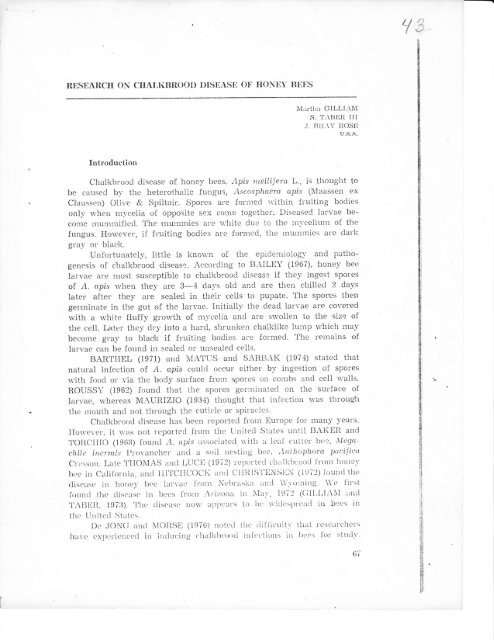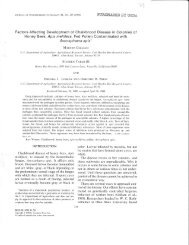Chalkbrood - Status Today and Hopes for Control' - Golden Rule Honey
Chalkbrood - Status Today and Hopes for Control' - Golden Rule Honey
Chalkbrood - Status Today and Hopes for Control' - Golden Rule Honey
You also want an ePaper? Increase the reach of your titles
YUMPU automatically turns print PDFs into web optimized ePapers that Google loves.
RIISEARC]II ON CHAI,I(I}R0OD I)IST]ASN ON }IONII}: BIiTiS<br />
Intloduction<br />
Nlrrr'tlrt GILLIr\l\t<br />
^S. T.\BER III<br />
J. Bt.t,\v ROSB<br />
u.s.A.<br />
Clralkbrood ,ciisease of hopey bees, ;lpis rrtelliJetu L.. is tirought to<br />
be c'atrsecl b1' the heterothulic fungus, ilscc.nphoet'n npis (i\'Iaassen ex<br />
Claussen) Olive & Spiltoir. Spores are <strong>for</strong>nleti t'ithin fruiting bodies<br />
onll' rvhen m,vce,lia o,f opposite sex cotlte together. Diseased larvae beconte<br />
ntunlrriifiecl. The unuurmies are rr,hite due to the r-n1-celiutn of the]<br />
fungus. HowerreL, if fluiting bodies arc folnrcd, tlte nruurrnies are clark<br />
grav or blac!.:.<br />
Unfoltunately, Iittle is knorvn o{ the epiderliolog3' <strong>and</strong> pathogenesis<br />
of chalkbrood diseas'^. Accolcling to B,\ILEY (1967), honel' bec<br />
lar-r'ae are rnost .susceptible to challibrood disease if the,v ingest spores<br />
of. A. apis rvhen they are 3-4 da1's old :rncl are then chilled 2 days<br />
later after they are sealed in their cells to pupate. 'I'he .spores then<br />
ger,rninate in lhe gut of the larvae. Initially the 'dead larvae are coYered<br />
rvith a u'hite fluffy growth of m1'celia ancl ar'e ss'olleu to the size of<br />
the ,celi. Late.r' they dry' into a hard, shrunlien chalklike lrtn-ip u'hich tnay<br />
becorne gra1.' to blaCli if fruiting bodies are <strong>for</strong>nred. llhe leuains of<br />
larvae can be <strong>for</strong>tnd ,in sealed or unsealed cells.<br />
BARTI{EL (1971) <strong>and</strong> l\IAi[tlS <strong>and</strong> SARI]'\K (197+) statcd t]rat<br />
natural infection of A. opis coulci occur eitlter bf ingestion of spores<br />
u'ith foocl or via the body sulface fronr spore's ot-t cotnbs allcl cell u'al.ls.<br />
ROUSSY (1962) found that the spores gennirlated on the sut'face of<br />
la5,ae, \vhereas MAURIZIO (1934) thought that inferctiou rt'as thloug'h<br />
the .rnoulh ancl not thlough the cutic'le or spilat:lc's.<br />
Chalhbloorl ,clisease has been repoltecl fl'om Ettrope lol lnany )'ears.<br />
]Iou,er,e.r'. it'rr.as not reportecl frclnr thr: t-initecl States r"rntil Br\KER ancl<br />
TOItCillO (l96tl) lor.rnci rt. opis associatccl ri'ith a lcal'c'uttcl llc,:, i\feortt'ltilc<br />
hternri.s I)r'clvanc:hel arrcl a soil rrestirrg ltet-, ,btlhoTthrtro p



